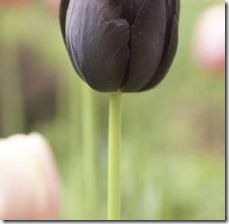Tulips, a genus of plants native to Asia, began appearing in western gardens in Holland in the 17th century. Since that time, gardeners and horticulturalists throughout the world have grown and experimented with tulips. Experiments in combining tulip genetic traits resulted in a handful of black tulip varieties. Black tulips add color and contrast to gardens, particularly in patchwork flowerbeds. They are readily available in the United States and grow just as easily as other tulips.
Types of Black Tulips
-
The Queen of Night tulip cultivar is the most common black tulip. The Queen of Night, a relatively tall perennial tulip reaching heights of 16 inches, retails at garden supply stores throughout the United States. Other types of black tulips include the Negrita, Black Swan and Recreado cultivars and the Black Tulip magnolia. As cultivars, the former three plants belong to the Tulip genus, Tulipa. The Black Tulipa magnolia hybrid belongs to the Magnolia genus. It is not a true tulip, but bears the name tulip for its flowers’ resemblance to those of tulips.
Colors of Black Tulips
-
No black tulip is totally black. Sarah Raven, author of "The Bold and Brilliant Garden," describes the Queen of Night cultivar as "almost black." The flower presents in dark maroon and is considered the darkest of the black tulips. The Black Swan cultivar exhibits a sky blue base and dark blue petals that appear black in most light. Black Tulip magnolias present in deep shades of burgundy that appear indistinguishable from black at first glance.
Origin of Black Tulips
-
Black tulips all constitute manmade varieties of flowers. The Black Tulip magnolia, a hybrid variety, is a species of flower created by horticulturalists for growth in controlled environments. Cultivars also represent plants developed by horticulturalists or botanists for growth in controlled environments but do not constitute actual species of plants. Plant breeders create black tulips by combining the genetic material of other plants to create a dark flower. While it is possible for such a flower to occur naturally, it would take a tremendous series of coincidences.
More Facts on Black Tulips
-
Cultivars, because they are not actual species of flowers, cannot create fertile seeds. Propagating cultivars in the home environment entails removing sections from a parent plant and replanting them to create new specimens. Some retailers have hybridized Queen of Night and sell plant bulbs. However, the plant does not possess a standardized set of genetic traits required of a true hybridized variety of flower.
Black tulips grow in U.S. Department of Agriculture plant hardiness zones 4 through 10, a wide range of climates. Though generally perennial, tulips grown in zones 9 and 10 grow as annuals because the extreme warmth prohibits the plants’ regular growth pattern.


Deprecated: strpos(): Passing null to parameter #1 ($haystack) of type string is deprecated in /home/agriviek8Qv/agriviet.net/public_html/wp-includes/comment-template.php on line 2522